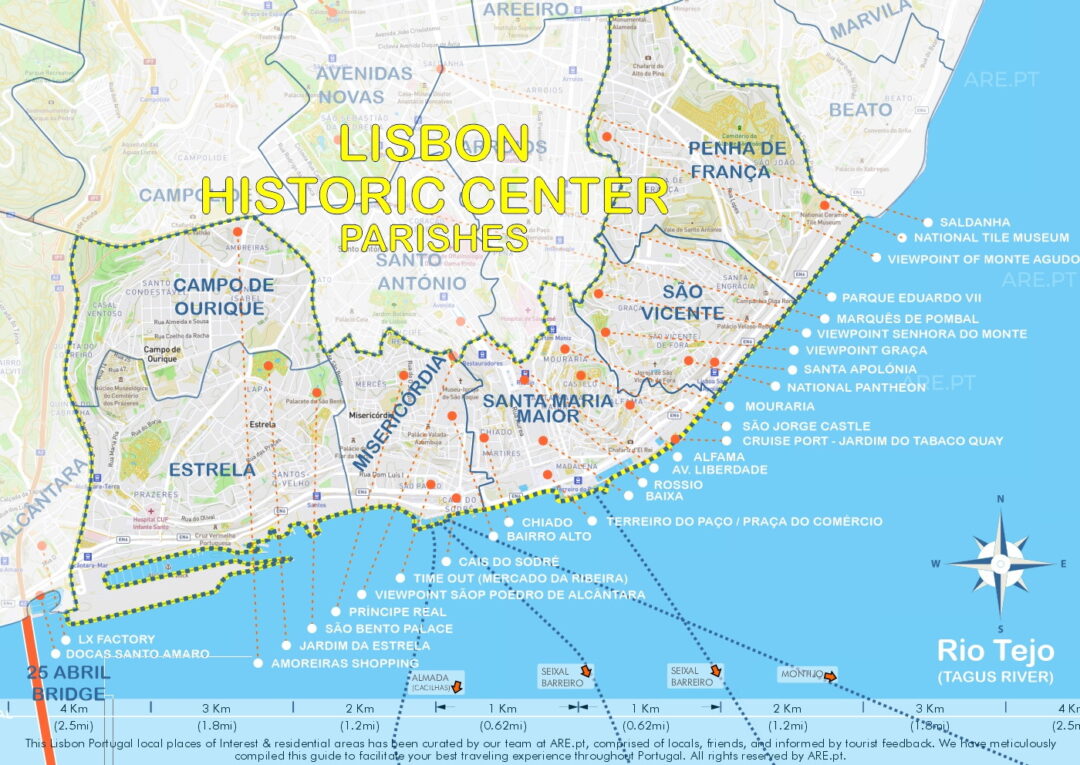
The Historic Center of Lisbon includes several parishes such as Estrela, Campo de Ourique, Misericordia, Santa Maria Maior, São Vicente, and Penha de França. This map highlights major attractions in these areas, showcasing the rich cultural and historical landmarks that define historic central Lisbon.
The historic center of Lisbon is the most ancient area of the city, encompassing a variety of neighborhoods renowned for their significant historical heritage. Many buildings, streets, and urban elements in these areas are indeed over a century old, with some structures dating back to medieval times.
Lisbon medieval neighborhoods in the city center
- Alfama: As one of Lisbon’s oldest districts, Alfama is notable for its labyrinthine streets, authentic Fado houses, and the imposing São Jorge Castle. Its origins trace back to the Moorish occupation of Lisbon.
- Baixa Pombalina (Downtown Lisbon): Reconstructed after the devastating earthquake of 1755, Baixa was planned under the Marquis of Pombal. It features a grid-like street plan and Pombaline architecture. Elements predating the earthquake are still evident in some structures.
- Chiado: A sophisticated district famous for its historic cafes, theaters, and bookshops. The area houses churches and theaters dating back to the 18th century and earlier, a long-standing status as a commercial and cultural hub.
- Bairro Alto: The neighborhood known for its bohemian vibe, nightlife, and 16th-century buildings and streets that retains much of its original layout.
- Mouraria: Mouraria is steeped in the history of Fado. Its urban fabric retains the medieval layout from its time as a Moorish quarter following the Christian reconquest.
- Castelo: Dominated by the São Jorge Castle, the Castelo neighborhood offers historical insights with its medieval walls and ancient structures. The castle dates back to the 11th century Moorish period.
- Graça: Perched atop one of Lisbon’s seven hills, Graça is celebrated for its 17th-century church and scenic overlooks. As one of Lisbon’s oldest suburbs, it features an array of historical buildings, with some predating the 18th century.
… mediaeval neighborhoods outside the central Lisbon
- Belém: Although the Belém district lies slightly outside the central city area, it features the Jerónimos Monastery and the Tower of Belém, some of the oldest and most prominent monuments in Lisbon, dating back to the Age of Discovery in the 16th century.
… historical Lisbon neighborhoods from the 18th and 19th centuries
Located north and west of the center, these areas developed as Lisbon expanded, particularly after the reconstruction of the Baixa in the 18th and 19th centuries.
- Avenida da Liberdade: This grand avenue marks the 19th-century northward expansion of the old city from Rossio. It is characterized by luxury shops, grand buildings, and theaters, reflecting the opulence of the time.
- Príncipe Real: Situated just beyond Bairro Alto, this neighborhood is known for its 19th-century mansions, lush gardens, and an eclectic mix of trendy and traditional shops and establishments.
- Santos: Formerly recognized as the city’s design district, Santos features buildings from the 18th and 19th centuries and for its antiques and design shops.
- Cais do Sodré: became particularly notable from the late 19th century into the 20th century, long been associated with maritime activities due to its proximity to the Tagus River. It has historically been a landing point for fish, a marketplace, and a gathering area for sailors. In the 20th century, retaining some of its historical maritime character, it continued to be known for its bustling environment, with bars, nightclubs, and restaurants that attracted sailors from the many ships that docked in Lisbon’s harbor.
… historical Lisbon neighborhoods from late 19th and 20th centuries
Located west of the previously mentioned neighborhoods, these areas developed in the later stages:
- Estrela: Renowned for the Estrela Basilica and the adjacent Estrela Garden, this district evolved into an important residential and political hub during the 19th century.
- Santos-o-Velho: Traditionally an industrial and port district, it features a blend of 18th- and 19th-century architecture.
- Rato: This locale, while experiencing development later on, still holds historical significance with several 19th-century constructions.
- Campo de Ourique: Emerging as a fully developed residential neighborhood by the early 20th century, it is known for its community atmosphere.
- Lapa: known for its luxurious mansions and embassies, indicative of its status as a wealthy residential area. The development of Lapa as an upscale neighborhood began predominantly in the late 18th century, continuing well into the 19th century, particularly after the 1755 Lisbon earthquake.
- Alcântara: situated beneath the 25 de Abril Bridge, has an industrial history stretching back to the 19th century, marked by factories for porcelain, textiles, soap, candles, and oils. The LX Factory, established in the 1840s, signifies the area’s industrial origins. In the early 1990s, Alcântara underwent a transformation from an industrial hub to a cultural quarter, with the development of pubs and discotheques and the conversion of the Santo Amaro Docks from warehouses to restaurants and discoteks.
Development Timeline of Lisbon’s Historic City
Lisbon’s storied past spans several millennia, with each era contributing distinctively to its growth:
Roman and Moorish Periods
The earliest settlements in Lisbon trace back to ancient times, with Roman and Moorish influences evident before the formation of Portugal as a nation. Notably, the remains of a 1st century CE Roman amphitheater are showcased at the Museu de Lisboa – Teatro Romano, situated in Alfama. We can view the main ruins of the theater from a designated walkway encircling the protected site.
Medieval Expansion
During the medieval period, particularly following the Reconquista in the 12th century, Lisbon saw significant expansion. The Monastery of São Vicente de Fora, embodying over 800 years of history and showcasing Manueline and Baroque architecture, stands in Alfama near the National Pantheon. Neighborhoods from this era, like Alfama, preserve the characteristic narrow streets and densely built environment.
16th and 17th Centuries
The Age of Discoveries in the 15th and 16th centuries transformed Lisbon into a pivotal global trading center. Prosperity during this time led to the creation of new districts to accommodate an economic boom. Noteworthy landmarks from this period include the Torre de Belém, Jeronimos Monastery, Discoveries Monument, and the Casa dos Bicos, among others.
1755 Earthquake and Marquis of Pombal’s Reforms
The 1755 earthquake, alongside subsequent tsunami and fires, wrought extensive destruction upon Lisbon, leading to a comprehensive reconstruction of the Baixa district. Guided by the Marquis of Pombal, an innovative grid plan was adopted for the new layout, which had a profound impact on the future urban development of the city. To understand this pivotal moment in Lisbon’s history, one can visit the Quake – Lisbon Earthquake Museum, which provides insights into the seismic event and its aftermath.
Industrialization and Expansion in the 1800s
The 19th century was a period of significant change for Lisbon, with industrialization acting as the catalyst for the creation of new neighborhoods and the extension of existing ones. Notable landmarks from this era include the Aqueduto das Águas Livres, completed in 1748, which is a testament to the engineering advances and public health initiatives of the time, providing the city with crucial water supply. The Rua Augusta Arch, another iconic structure, was built to commemorate the city’s reconstruction after the 1755 earthquake and represents the triumph of Lisbon’s spirit over adversity.
Estado Novo Regime
During the Estado Novo period (1933-1974), substantial modernization and urban planning efforts took place. New districts were established, and existing areas were expanded or renovated, integrating wider streets and modern housing. This is exemplified by the architectural style of “Português Suave,” particularly evident in the Avenidas Novas.
Post-1974
The Carnation Revolution of 1974 initiated a democratic and economic resurgence in Portugal. This era saw the expansion of public transportation, the establishment of new cultural facilities, and the revitalization of waterfront areas. Landmarks of this period include 25 April Revolution Monument by João Cutileiro in Parque Eduardo VII.
Lisbon is a city with milleniums of History!
Sample of homes for sale in Lisbon Historic Center
-

Apartment for sale in Príncipe Real, Lisbon
Reference 33015 Bedrooms 2 bedrooms Interior area 85.0 m2 Price 880 000€ -

Apartment for sale in Alfama 83,
Reference 34081 Bedrooms 2 bedrooms Interior area 129.0 m2 Price 1 490 000€ -

Apartment for sale in Alfama 83,
Reference 34083 Bedrooms 3 bedrooms Interior area 189.0 m2 Price 2 190 000€ -

Apartment for sale in Alfama 83,
Reference 34084 Bedrooms 1 bedroom Interior area 86.0 m2 Price 995 000€ -

Apartment for sale in Alfama 83,
Reference 34090 Bedrooms 4 bedrooms Interior area 331.0 m2 Price 5 990 000€ -

Apartment for sale in Alfama 83,
Reference 34089 Bedrooms 2 bedrooms Interior area 180.0 m2 Price 3 490 000€ -

Apartment for sale in Alfama 83,
Reference 34088 Bedrooms 2 bedrooms Interior area 134.0 m2 Price 2 490 000€ -

Apartment for sale in Alfama 83,
Reference 34085 Bedrooms 2 bedrooms Interior area 118.0 m2 Price 1 690 000€ -

Apartment for sale in Alfama 83,
Reference 34079 Bedrooms 2 bedrooms Interior area 170.0 m2 Price 1 890 000€ -

Apartment for sale in Alfama 83,
Reference 34068 Bedrooms 2 bedrooms Interior area 158.0 m2 Price 1 995 000€ -

Apartment for sale in Alfama 83,
Reference 34087 Bedrooms 2 bedrooms Interior area 121.4 m2 Price 1 690 000€

